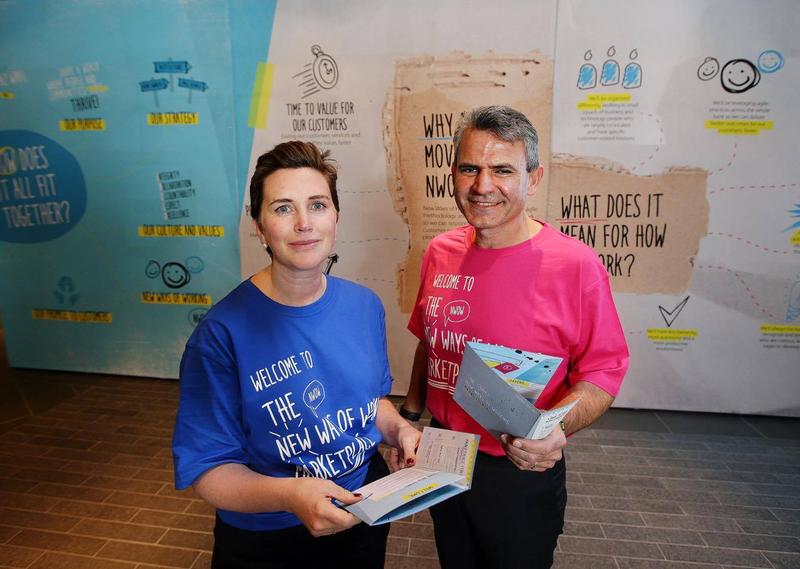ANZ pitches 'NWOW' agile approach to employees as roll-out begins
- 21 August, 2017 13:01

For three days last week, the lobby level of ANZ Bank’s Melbourne headquarters was turned into a bustling marketplace.
There were billboard sized information displays and stalls with miniature models of office furniture. There were give-aways, games and glossary pamphlets, and a pop-up cinema complete with beanbags.
I visited the launch expo @ANZ_AU New Way of Working #NWOW in Melbourne today - super impressive. I reckon they've got this! Thx @kaytedid pic.twitter.com/BUNTVIOh7M
— Nigel Dalton (@nxdnz) August 16, 2017
On sale was a concept, familiar to some who work at the bank’s Dockside offices, but new to most: agile working.
The bank’s own-brand of ‘scaled agile’ has been named New Ways of Workings or NWOW. Announced in May by CEO Shayne Elliott, the bank believes the organisational style and associated methodologies, will help it respond more quickly to customer needs, create higher staff engagement and boost efficiency.
With origins in software development in the early noughties, the approach has since been utilised in some way by many of the world’s biggest brands. Domestically, the likes of Australia Post, Telstra, and ANZ’s banking rivals are also realising the benefits.
There’s a lot more to it than a bulk order of Post-It notes and the buzzwords (squad, tribe, chapter, sprint) listed on the back of the marketplace map.
For those attending the introductory event last week, it will mean working with new faces, possibly in a different place, and someone else to call boss (or should that be 'coach'?).
The shake-up will also thaw what ANZ group executive of digital banking Maile Carnegie called the “frozen middle” management layer who will “resist change like death”. Elliott has confirmed that jobs will be lost as a result of the transformation.
Tasked with making NWOW stick across the bank’s Australia division is Katherine Bray, managing director products. The 'launch at scale' has a deadline of just after Australia Day next year.
“By that stage we really want to be able to look out to the floors, and see teams working differently, at scale across this organisation, across this building,” she says. “It is just a more energising, more empowering, more collaborative, higher metabolic rate way of working.”

Breaking down barriers
On Monday, in a room four floors above the hustle and bustle of the marketplace set-up, Bray and group executive technology Gerard Florian met with CIO Australia and other media outlets to discuss the ambitious project.
At the entrance to the NWOW ‘basecamp’ is an analog digital timer counting down towards the launch. By then, ANZ expects around 4,000 staff to have transitioned to its NWOW.
“Actually I don’t think we really bought into that urgency until the morning everyone came in and it had fallen below 200 days. And there was a sudden reaction like ‘oh my goodness’,” Bray says.
Bray’s team is 13 “intensive” weeks into the effort, which is itself being run agile (“We’re practicing what we preach,” Bray notes).
“[We’re] moving from the software developers delivering projects, technology stuff, which is not uncommon and part of our history, to actually working like this at scale across the organisation. Not just in the way that we build new stuff, and change, but actually in the way that we run the bank. Very much the day to day running of the bank,” says Bray, wearing a bright blue NWOW tee-shirt under her business blazer.
“We’re talking about breaking down the functional barriers of our business, and organising ourselves in these multidisciplinary teams, leveraging agile practices,” she adds.
Great energy at ANZ today as we launch our New Ways of Working marketplace - an oppty to learn for all of us. pic.twitter.com/xXszuaLj8X
— Shayne Elliott (@ElliottShayne) August 14, 2017
Page Break
ANZ has utilised agile working practices for around four years. The approach is used in technology and product teams to deliver around a fifth of technology and digital projects at the bank including, under Bray’s leadership, Apple Pay and a feature which automatically updates customers’ digital wallets with replacement card details if they report one lost or stolen.
The bank last week began a formal process to appoint a systems integration partner "to assist in the scoping and design of our technology architecture" to support its new organisation-wide agile approach.
“In order to keep that cadence high we have to move from the organisational structure that’s been common in many large organisations to this more multidisciplinary team where software developers and product people and the legal teams and security and everybody who needs to be involved is sitting around that table making decisions and helping us get features out in rapid succession,” explains Florian, who joined the bank in November last year from Dimension Data.
Move on up
Not every worker in the bank’s Australian division will be moving to NWOW.
Frontline staff working in branches won’t adopt the approach (“They already kind of work in a squad anyway,” says Florian, “some of the behaviours are actually already there”), nor will those in operations, distribution or fulfillment. Those in legal and human resources are likely to be ‘jumping in and out’ of squads when required.
“We’re trying not to be purist about it,” Bray says. “This is really looking across the landscape and saying – where are the areas that really benefit? Digital, product, marketing, data, projects – these sorts of areas.”
Another major change, aside from the day to day way of working, is the way employees progress their careers within the bank.
“So what we’re looking at in terms of career path is when you remove a lot of that hierarchy, you do suspend that notion of how to move ahead. [NWOW has] got to be about encouraging breadth and experience and mastery of a topic and people being continued practitioners,” Bray says.
“It is recognising and rewarding a different version of ambition which is much less about moving up, and much more about growth and mastery.”
A much bigger focus will be put on learning with individuals encouraged to expand their skill set. Some 750 staff began their agile training this week.
A buzz that won’t stop
With the marketplace now packed up, the challenge for the bank is now to maintain interest and momentum in NWOW.
Quiet this morning without the buzz of the #NWOWMarketPlace but onwards with our #newwaysofworking #transformation...
— Katherine Bray (@Kath_Bray) August 16, 2017
“That buzz is great – we don’t expect that to stay at that level the whole time. We need to keep finding ways to reinvigorate and keep people interested and engaged around what we’re doing,” Florian says.
“We recognise that whilst there is a lot of theatre here in the room, at the end of the day this is people and people going on a fairly significant change. The risk is…we have people [who can] see it academically, but do they believe in here that they can do it and we can do it altogether? That’s the risk.”
The work will never be over, Bray adds.
“There is of course a risk that day one – everything’s done, high five in the corridor, move on, transformation over. Well that’s not the nature of this. There are many elements of this that will take time to mature and embed and that will continuously improve our efficiency over time. And that requires tenacity,” she says. “We’re clear where we are on the journey with an understanding that we will never be done.”

